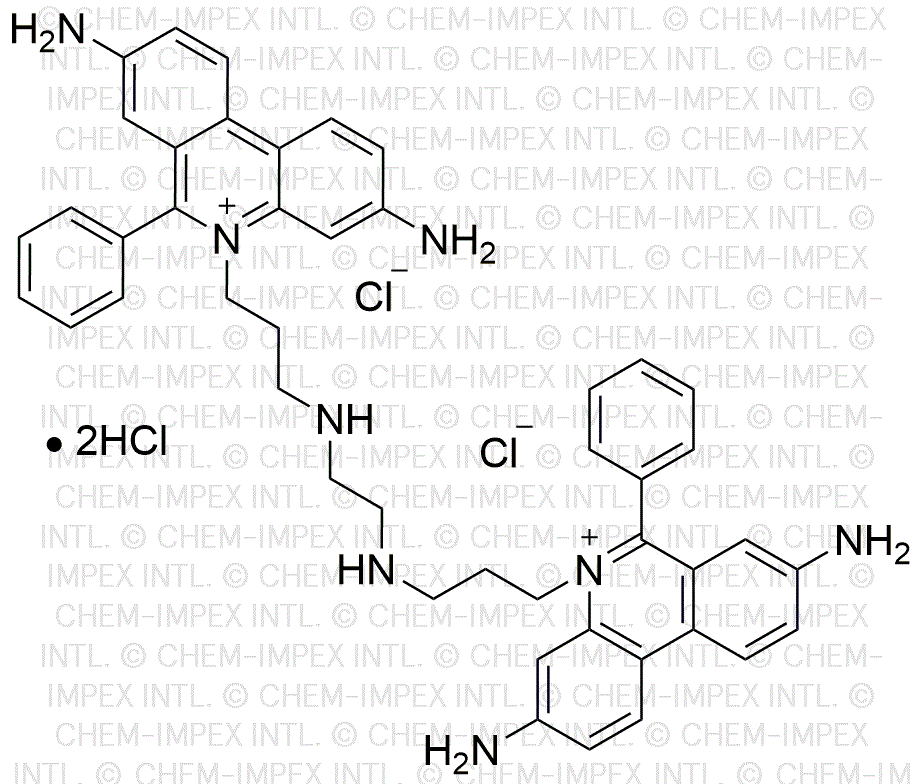Ethidium homodimer is widely utilized in research focused on:
- Nucleic Acid Staining: This compound is primarily used in molecular biology for staining DNA in gels. Its ability to intercalate between base pairs allows for easy visualization of nucleic acids during electrophoresis, making it essential for researchers analyzing genetic material.
- Cell Viability Assays: Ethidium homodimer is employed in assays to determine cell viability. It selectively enters dead or dying cells, allowing researchers to differentiate between live and dead cells, which is crucial in drug testing and toxicity studies.
- Fluorescence Microscopy: In microscopy applications, this chemical enhances the visualization of cellular structures. Its fluorescent properties enable researchers to study cellular processes and dynamics in real-time, providing insights into cellular functions.
- Apoptosis Studies: The compound is used to investigate programmed cell death (apoptosis). By assessing the uptake of ethidium homodimer, researchers can determine the integrity of cell membranes, which is vital for understanding cancer and other diseases.
- Genetic Research: Ethidium homodimer plays a role in various genetic studies, including PCR and cloning. Its effectiveness in detecting DNA fragments makes it a valuable tool for genetic engineering and molecular cloning applications.
General Information
Properties
Safety and Regulations
Applications
Ethidium homodimer is widely utilized in research focused on:
- Nucleic Acid Staining: This compound is primarily used in molecular biology for staining DNA in gels. Its ability to intercalate between base pairs allows for easy visualization of nucleic acids during electrophoresis, making it essential for researchers analyzing genetic material.
- Cell Viability Assays: Ethidium homodimer is employed in assays to determine cell viability. It selectively enters dead or dying cells, allowing researchers to differentiate between live and dead cells, which is crucial in drug testing and toxicity studies.
- Fluorescence Microscopy: In microscopy applications, this chemical enhances the visualization of cellular structures. Its fluorescent properties enable researchers to study cellular processes and dynamics in real-time, providing insights into cellular functions.
- Apoptosis Studies: The compound is used to investigate programmed cell death (apoptosis). By assessing the uptake of ethidium homodimer, researchers can determine the integrity of cell membranes, which is vital for understanding cancer and other diseases.
- Genetic Research: Ethidium homodimer plays a role in various genetic studies, including PCR and cloning. Its effectiveness in detecting DNA fragments makes it a valuable tool for genetic engineering and molecular cloning applications.
Documents
Safety Data Sheets (SDS)
The SDS provides comprehensive safety information on handling, storage, and disposal of the product.
Product Specification (PS)
The PS provides a comprehensive breakdown of the product’s properties, including chemical composition, physical state, purity, and storage requirements. It also details acceptable quality ranges and the product's intended applications.
Certificates of Analysis (COA)
Search for Certificates of Analysis (COA) by entering the products Lot Number. Lot and Batch Numbers can be found on a product’s label following the words ‘Lot’ or ‘Batch’.
Numéro de catalogue
Numéro de lot/série
Certificates Of Origin (COO)
This COO confirms the country where the product was manufactured, and also details the materials and components used in it and whether it is derived from natural, synthetic, or other specific sources. This certificate may be required for customs, trade, and regulatory compliance.
Numéro de catalogue
Numéro de lot/série
Safety Data Sheets (SDS)
The SDS provides comprehensive safety information on handling, storage, and disposal of the product.
DownloadProduct Specification (PS)
The PS provides a comprehensive breakdown of the product’s properties, including chemical composition, physical state, purity, and storage requirements. It also details acceptable quality ranges and the product's intended applications.
DownloadCertificates of Analysis (COA)
Search for Certificates of Analysis (COA) by entering the products Lot Number. Lot and Batch Numbers can be found on a product’s label following the words ‘Lot’ or ‘Batch’.
Numéro de catalogue
Numéro de lot/série
Certificates Of Origin (COO)
This COO confirms the country where the product was manufactured, and also details the materials and components used in it and whether it is derived from natural, synthetic, or other specific sources. This certificate may be required for customs, trade, and regulatory compliance.


